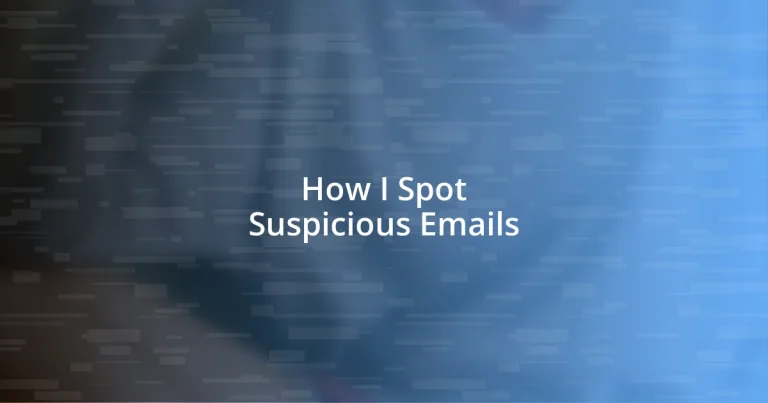Key takeaways:
- Suspicious emails often exploit urgency and fear, leveraging emotional manipulation to prompt hasty responses, making it vital to pause and evaluate before acting.
- Key red flags include unfamiliar sender addresses, urgent language, requests for sensitive information, and generic greetings—careful scrutiny can help identify potential scams.
- Utilizing email verification tools and reporting suspicious emails enhances personal security and contributes to safeguarding the broader community from phishing attempts.
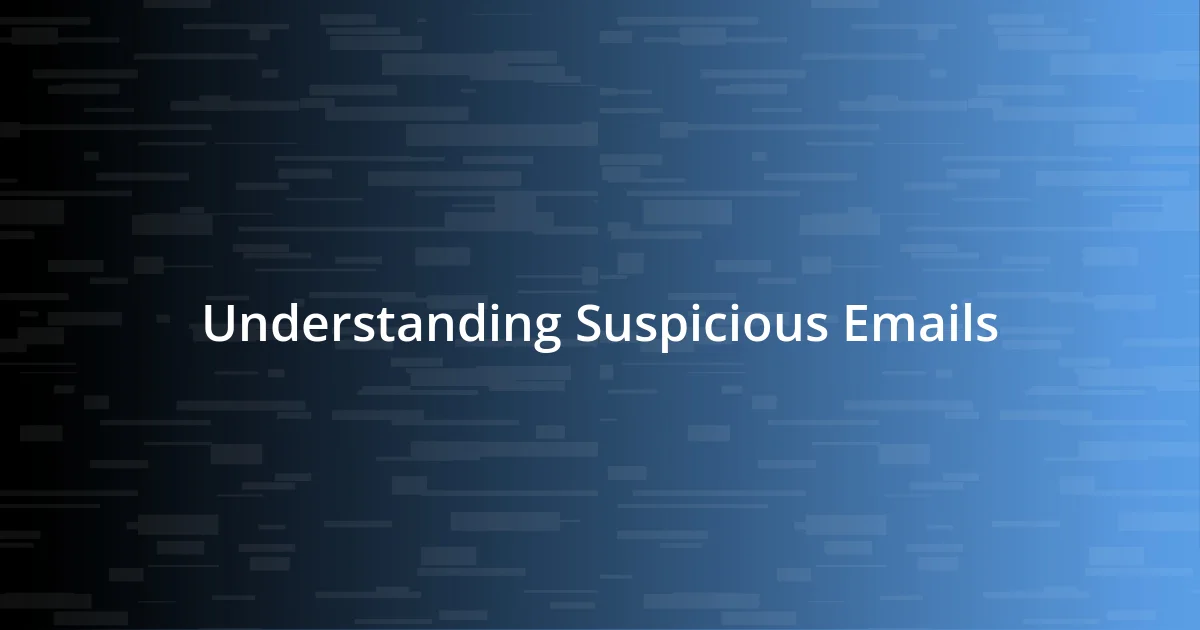
Understanding Suspicious Emails
When I first started navigating my inbox, I was often caught off guard by emails that looked legitimate. What I didn’t realize then was that suspicious emails often leverage urgency or fear to prompt quick reactions. For instance, I once received a message claiming my account would be locked unless I verified my details immediately. It’s startling how easily we can be led into a state of panic, isn’t it?
Suspicious emails frequently come with tell-tale signs—like poor grammar, unusual sender addresses, or awkwardly phrased requests. I remember spotting a so-called “official” message that asked for my password, worded in the most convoluted manner. It hit me then: an authentic company wouldn’t phrase things that way. How often do we overlook these red flags in the heat of the moment?
Understanding the psychology behind these emails helps us build a robust defense. They prey on our emotions, making us susceptible to manipulation. Reflecting on my earlier experiences, I realize that if I had taken a moment to breathe and evaluate before responding, I could have avoided potential pitfalls. And isn’t it true that sometimes, a little pause can save us from a lot of regret?
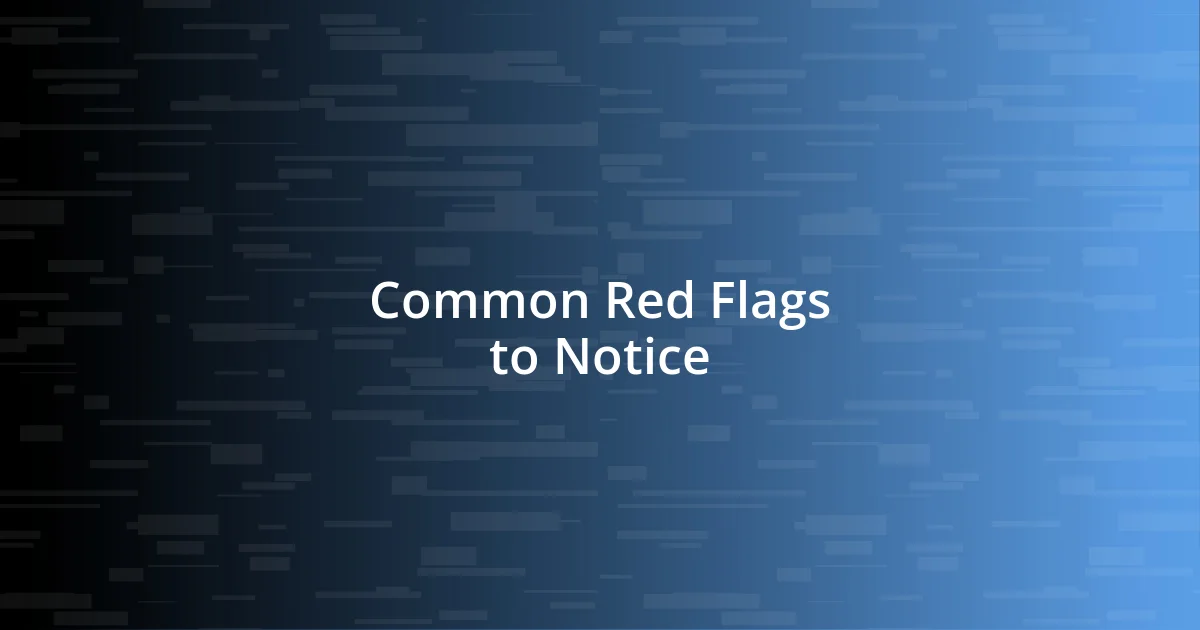
Common Red Flags to Notice
When evaluating emails, there are several common red flags that shouldn’t be ignored. I remember a time when I received an email from what appeared to be my bank, asking for my account information. It had the bank’s logo but the email address was completely off. That minor detail made me realize how easily one can get duped by something that looks familiar.
Here are some key indicators to watch for:
- Unfamiliar sender: Always double-check the sender’s email address. Phishing attempts often come from addresses that are slightly altered.
- Urgent language: If the email insists you act quickly or face dire consequences, take a moment to question its legitimacy.
- Generic greetings: Be wary of messages that start with “Dear Customer” instead of using your name, as they may not be targeted to you personally.
- Requests for sensitive information: Legitimate companies will rarely ask for personal details via email.
- Links or attachments: Hover over links to verify their destination before clicking, and be cautious about unsolicited attachments.
These experiences have taught me that a careful eye can make all the difference in avoiding scams. A little skepticism goes a long way.
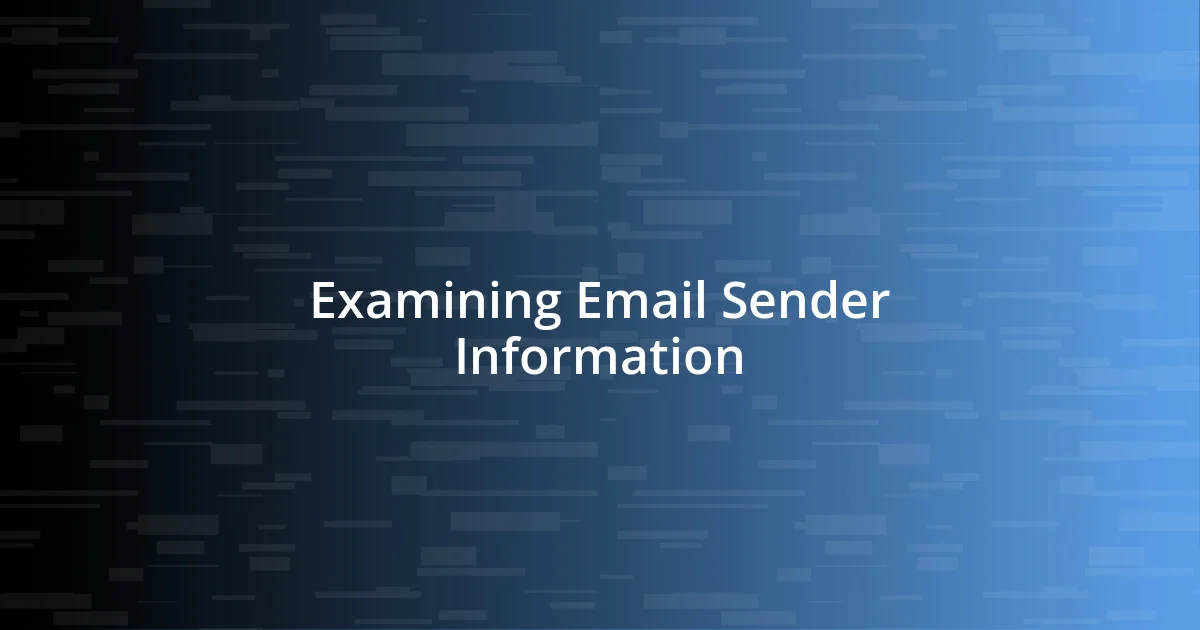
Examining Email Sender Information
When I first started scrutinizing the sender information in emails, I discovered how crucial this step is for spotting scams. I remember receiving an email that looked almost identical to one from a popular retailer. At first glance, I was convinced it was legitimate, until I noticed the sender’s address was a mishmash of letters and numbers rather than the familiar name. It was a stark reminder of how often we overlook these details in the hustle of our daily routines.
Identifying the sender’s email address can reveal a lot about an email’s authenticity. I once received a supposedly urgent update from a friend, but the email had a bizarre domain name that didn’t match their usual address. Checking the details before reacting saved me from potential embarrassment and further complications. I learned over time that a simple moment of inspection can prevent unnecessary stress down the road.
Additionally, examining the full email headers can provide a clearer picture of where the email originated. I vividly recall digging into an email that raised my suspicions; the header revealed it was routed through multiple unwarranted servers. This experience taught me that the trail of an email often tells a more substantial story than its content. If we take a moment to analyze these details, we can protect ourselves from those who attempt to deceive us.
| Indicator | Example |
|---|---|
| Unusual Sender Address | info@fake-retailer123.com |
| Disguised Domain Name | support@bank-secure-info.com |

Analyzing Language and Tone
When analyzing the language and tone of an email, my instincts often kick in right away. I recall receiving a message that used overly dramatic language, warning me my account would be “permanently suspended” unless I acted immediately. It felt alarmist and out of place for a legitimate company; that’s when I knew to be cautious. Have you ever noticed that some emails seem almost too urgent or intense? It’s a tactic that phishers frequently use to create panic and prompt hasty responses.
Another telltale sign is the tone of the email. I’ll never forget an email that addressed me in a casual, overly familiar way, using phrases like “Hey, buddy!” while claiming to represent a formal institution. This jarring contrast in tone made me question its authenticity. Professionals generally maintain a specific level of formality, so if an email feels off, it probably is. Have you come across similar experiences where the language just didn’t match the sender’s alleged profile?
Finally, I always scrutinize the overall writing quality in these emails. There was one time when I received what looked like an important invoice, but the language was riddled with typos and awkward phrasing. This inconsistency was a red flag, and it made me realize how crucial it is to trust my gut. Does the writing sound professional? Errors can indicate that the email is not from a credible source, and it’s a simple yet effective way to filter out dubious messages.
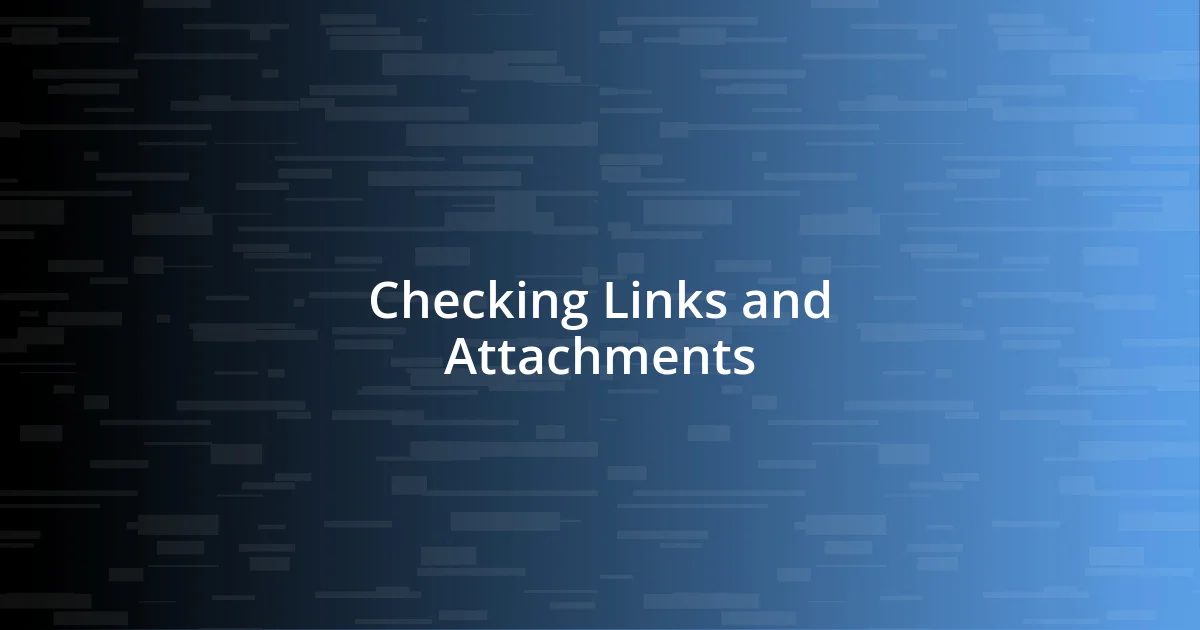
Checking Links and Attachments
I often find that checking links in an email is more telling than it might first appear. There was a moment when I clicked on a link that led to what seemed to be my bank’s website. But my heart sank as I noticed the URL had an unfamiliar extension. I immediately closed the tab and felt a mix of relief and anxiety. Have you ever considered just how deceptive a well-crafted link can be? I learned to hover over the link to reveal where it would take me before clicking—it’s a small action that could save you from potential disaster.
Attachments are another area where I tread cautiously. One instance that stands out is when I received a seemingly harmless PDF labeled “Invoice.” It looked professional at first, but my gut told me to pause. Instead of opening it, I contacted the sender directly to verify. It turned out they hadn’t sent anything at all. This taught me that even familiar connections can sometimes lead us astray. How often do we assume that attachments are safe because we recognize the sender’s name? By taking a moment to double-check, I learned to protect myself from malware or phishing attempts cleverly disguised as legitimate documents.
I pay close attention to the context of the email too. If I receive a message from a retailer I frequent, but the email claims to have an exciting “exclusive offer” with an unusual attachment, I get suspicious. I remember one email that appeared to be from my favorite online store, complete with enticing deals but with an attachment that just didn’t fit. Ignoring that attachment felt like the right move, and it turned out my instincts were spot on. What strange or unexpected attachments have you encountered? Trusting your instincts can prevent falling into traps that, at first glance, might seem too good to be true.
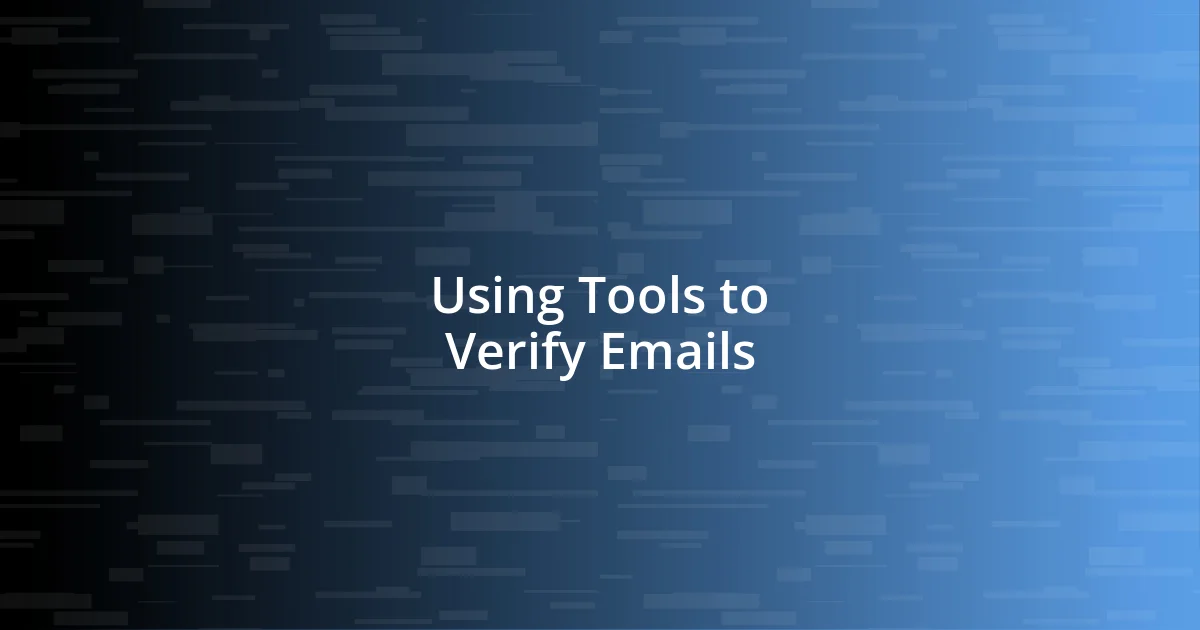
Using Tools to Verify Emails
Using tools to verify emails is a game-changer, and I’ve found several resources to be incredibly helpful. For instance, I often use email verification tools like Hunter.io or NeverBounce. Just last week, I got an email that seemed suspicious, and by running the sender’s address through one of these tools, I discovered it was linked to a temporary domain. It felt reassuring to confirm my instincts and avoid a potential scam. Have you ever tried using an email verification tool to uncover something unexpected?
Another resource I frequently utilize is domain look-up services. There was a time when I received a message claiming to be from a well-known charity, but something felt off about the sender’s domain. By using a look-up service, I found that the domain was recently registered and had no history. It gave me a sense of empowerment—I had evidence to back up my hesitation. Isn’t it liberating to validate your gut feelings with hard data?
I also appreciate browser extensions that flag suspicious emails right in my inbox. Just the other day, I received a message with enticing offers. My trusty extension raised a red flag, indicating it wasn’t secure. This tool has helped me dodge several fraudulent attempts, saving me both time and frustration. How often do you rely on technology to enhance your instinct for spotting fraud? It truly makes a difference in my daily email habits.
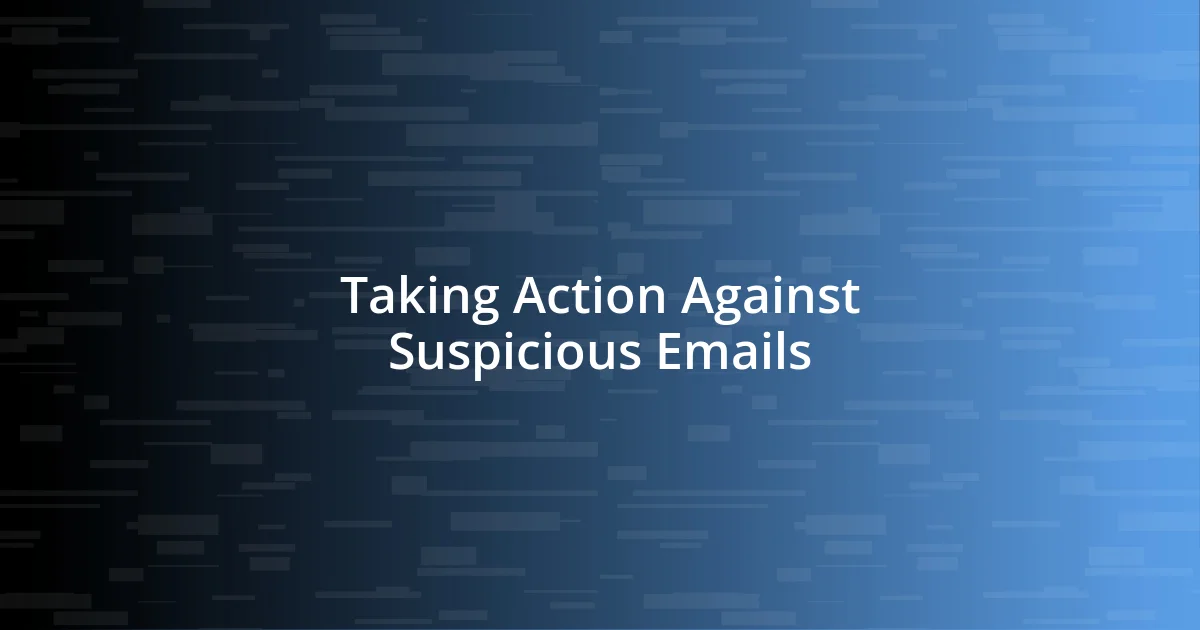
Taking Action Against Suspicious Emails
Taking swift action when faced with a suspicious email is crucial. Recently, I received an email that claimed to be from an “urgent security team,” threatening to suspend my account. My heart raced, but instead of responding immediately, I took a deep breath and checked the sender’s address. It was a misspelled version of the company’s domain. I couldn’t believe how easily I could have fallen for that. Have you ever paused to verify an email, only to uncover a possible fraud?
Once I determine an email is suspicious, I never hesitate to report it. Just a few weeks back, I stumbled upon a phishing email promising an unbelievable cash prize. I forwarded it to my email provider’s abuse team. This small act gave me a surprising sense of satisfaction, knowing I was potentially protecting others while reclaiming my peace of mind. It made me wonder—how many times have we let our guard down, thinking someone else will handle the problem?
In my experience, blocking the sender is another critical step I always take. After opening a fraudulent email that promised investment success, I quickly added that address to my block list. I felt empowered knowing that I wouldn’t receive further attempts to mislead me. Blocking an email not only protects my inbox but also sends a message that I take my online security seriously. How often do you think about the impact of your actions on your digital safety?












